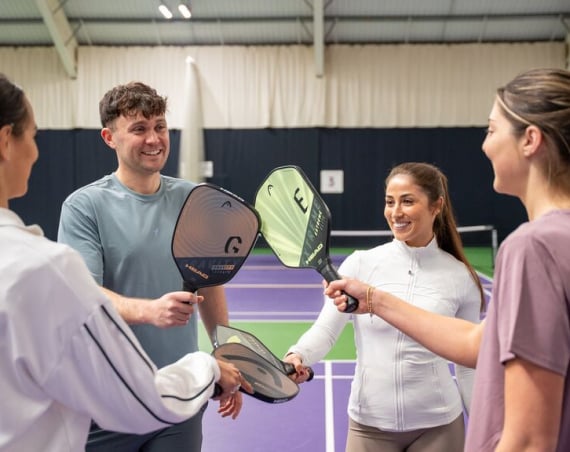Ready to step onto the tennis court, racquet in hand, and start a new fitness adventure? We’re here to support your journey into the exciting world of tennis a sport that’s not only great for your physical fitness but for your social and mental well-being too.
But let’s not get ahead of ourselves. As a beginner, getting the basic techniques right is key. Master the right stroke, footwork and body position from day one, and you won’t have to unlearn bad habits later on. Fortunately, with the right guidance and a bit of dedication, you’ll be enjoying the game and reaping its benefits in no time.
Start your tennis journey right now as we cover the basics with our straightforward guide to the key techniques, complete with simple instructions and helpful illustrations.
Get a grip
Understanding different grips is an essential step for beginners in tennis. Each grip provides a unique way to control your racquet and manipulate the ball’s trajectory — including power, spin, and accuracy — allowing you to adapt to various game situations. By learning these different grips early in your training, you can build a solid foundation for your developing tennis skills.

Note: that we’ll be referring to bevels, which refer to the eight facets or faces on the handle of the racquet. These bevels, or edges, are used as reference points for the grip. They allow players to adjust their hand position and hence control the direction and spin of the ball when they hit it.
Continental grip
Hold the racquet with the edge facing the floor. The “v” created by the point where your thumb and forefinger meet should be on the centre bevel of the racquet, meaning it faces you when you hold your racquet straight up in front of you. Also known as the chopper grip, this is used when serving the ball.

Eastern Forehand
Most people use the eastern forehand grip. Hold the handle as if you are shaking hands with it. Again, the “v” created by the point where your thumb and forefinger meet should be on or next to the centre bevel on the handle.

Semi-western Forehand
Some players prefer the semi-western grip. Hold the racquet with the edge facing the floor. The “v” created by the point where your thumb and forefinger meet should align with the handle’s outside bevel.

Double-handed backhand
Hold the racquet so the edge of it is facing the ground and place your dominant hand at the bottom of the handle. Comfortably place your other hand above it, keeping your hands close together so they work as one unit.
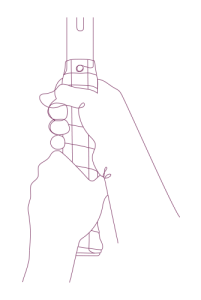
Single-handed backhand
From the continental grip rotate your hand anti-clockwise for right-handed players or clockwise for left-handed players. The “v” created by your forefinger and thumb should be further away from the centre bevel than it is in the continental grip.
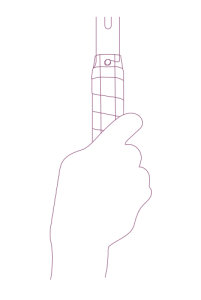
Move your feet
Footwork and movement fundamentals are vital for tennis beginners because they directly impact your ability to reach and properly return the ball. Good footwork enables quick, agile movements and efficient positioning on the court, making it easier to respond to different types of shots. Strong footwork and the right tennis shoes can also mean less physical strain during matches.
Ready position
Hold the racquet centrally to your body, bend your knees and place your weight on the balls of your feet.
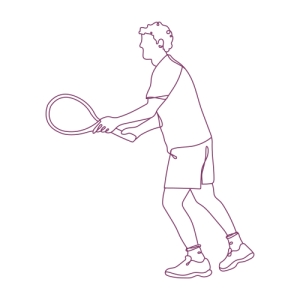
Split step
This is a momentary step, taken when your opponent hits the ball, allowing you to move in either direction. When your opponent hits the ball, bounce lightly in a balanced position with your body facing the ball.
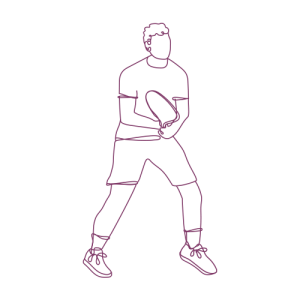
Move towards the ball
Depending on how far you will need to move to return the ball, you will require a mixture of long and short strides. Long strides should be taken to get to the ball and short strides should be used to make minimal adjustments when you are ready to return the ball.
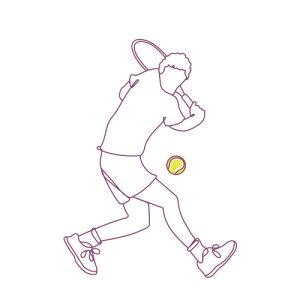
Basic serve
Tennis consists of six basic strokes: the serve, forehand, backhand, forehand volley, backhand volley, and the overhead smash. These are the fundamental movements a player performs to hit a tennis ball.
To get you started on the court, we’re going to focus on the serve and forehand, as well as two varieties of backhand: single-handed and double-handed.
Position
Start by holding the racquet using the continental grip as shown above. Your starting position on the court should be behind the baseline and close to the centre mark, which will allow you to cover the middle of the court when your opponent returns the ball. Stand sideways to the court with your non-racquet side closest to the net. Your feet should be about shoulder width apart and 45 degrees to the baseline. Your weight should be slightly over your front foot with the racquet in front of you and the ball held on the strings or throat (the triangular area between the racquet’s face and the grip).
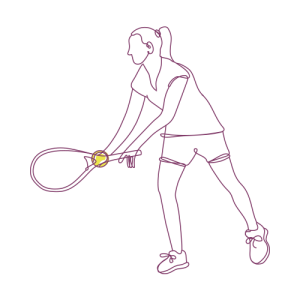
Toss
You want to initiate your serve by tossing the ball up. Push your weight to the back foot and toss the ball up using a straight arm. The toss should be slightly higher than you can reach with your racquet and in front of you so the ball would drop inside the court. Your racquet arm should come back and your hips and shoulders should rotate away from the ball.
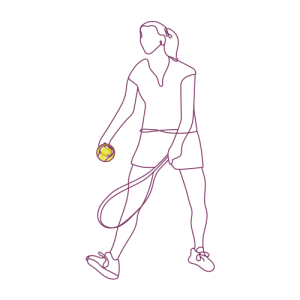
Backswing
As you start the toss, your racquet arm should come back and your hips and shoulders should rotate away from the court. Your knees should be slightly bent and the racquet should be ready to hit the ball. Keep your eyes on the ball at all times during your backswing.

Hit the ball
As you rotate back towards the court, you should drive your body up towards the ball while performing an overhead throwing action with your racquet. You should aim to hit the ball just as it starts to descend from its highest point. The momentum of the follow-through may move you into the court, so aim to recover quickly and drop back behind the baseline.
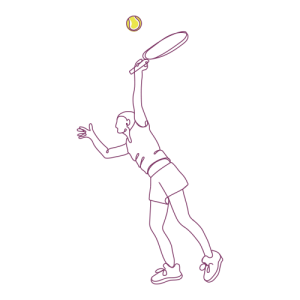
Basic forehand
Position & backswing
You will need to use either the eastern forehand or semi-western grip for a forehand shot. After the split step, move towards the ball while keeping an eye on where it bounces. Position yourself using small strides so that you are side-on and slightly behind the ball. At the maximum point of your backswing, your weight should be over your back foot with your racquet lower than the ball.
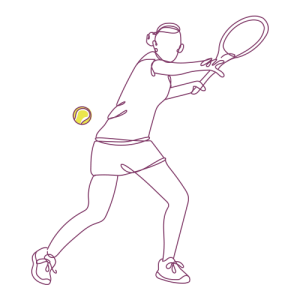
Hit the ball
From the backswing position, shift your weight from the back foot onto the front. Swing your racquet towards the ball with a low-to-high movement. During your swing, rotate your body so that you make contact with the ball with your body facing it. Contact should be made with the ball around hip height and when the ball is in front of your body position.
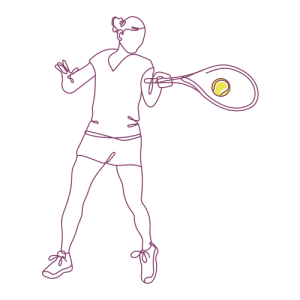
Double-handed backhand
Position & movement
The double backhand grip as demonstrated above will be needed for this shot. Start in a ready position with your knees bent and your weight on the balls of your feet. Split step as your opponent hits the ball and then move towards the ball’s path while keeping your eye on it. Turn your hips and shoulders and move so that you will contact the ball when it is to the side of you and slightly in front.

Drawback
With the weight on your back foot, move your front foot towards the ball while drawing your racquet back in anticipation of hitting the ball. The racquet should follow a low-to-high path, so at this point, the racquet head should be below the point you want to hit the ball.
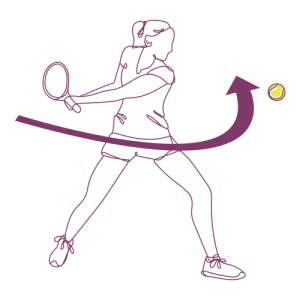
Hit the ball
After pulling the racquet back, transfer your weight onto your front foot. Some players will hit the ball with bent elbows, meaning the contact point should be slightly closer to your body. If you hit the ball with straight arms, the contact point should be slightly further away from your body. Aim to hit the ball when it is just in front of you and at waist height. As you swing through the ball, your body should rotate.
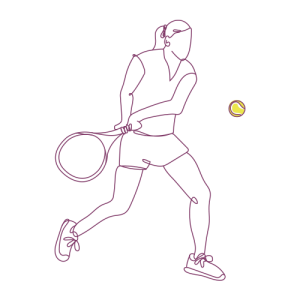
Single-handed backhand
Position & movement
A single-handed backhand grip will be needed for this shot. Start in a ready position with your knees bent and your weight on the balls of your feet. Split step as your opponent hits the ball and then move towards the ball’s path while keeping an eye on it. Turn your hips and shoulders and move so that you will contact the ball when it is to the side of you and slightly in front. During this movement, you will need to adjust your grip to the continental grip.

Drawback
With the weight on your back foot and your feet shoulder-width apart, draw your racquet back in anticipation of hitting the ball. The movement of the racquet will be more of a looped action, so the racquet head needs to be in a high position at the point of the drawback. You should use your second hand to guide this movement. Your shoulders should be the side of the oncoming ball.

Hit the ball
Push your weight onto your front foot while stepping into the stroke. Let the racquet fall so that it hits the ball with a low-to-high motion. Aim to hit the ball slightly in front of you and at about waist height. The racquet should finish high as you follow through the ball.

Work on your game at David Lloyd Clubs
Now that we’ve covered the basics, there’s only one thing left to do: Contact your local club for more information about getting started with tennis and other racquets sports.
We recommend working with our qualified tennis coaches in sessions that will not only boost your performance but enhance your overall enjoyment. They’re also a great way to form new friendships with your fellow members.
Find a club

